

SELCompetencies. CASEL Equity Insights Report. How to Maslow Before Bloom, All Day Long. “Maslow before Bloom”—we hear it all the time.
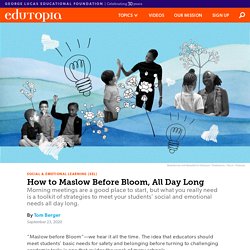
The idea that educators should meet students’ basic needs for safety and belonging before turning to challenging academic tasks is one that guides the work of many schools.
SEL Lessons Based on Children's Books. Teaching Students Responsible Decision Making. Social Emotional Learning Books. 19 Great Learning Podcasts for the Classroom. Add diverse voices and fresh content to your lessons with free, high-quality podcasts.
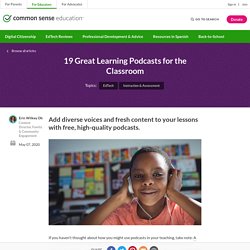
If you haven't thought about how you might use podcasts in your teaching, take note: A 2019 study found that over 50% of people in the U.S. age 12 and up have listened to a podcast. In addition, podcast listening among young people age 12-24 increased 48% from 2017 to 2019. This fresh, engaging medium has gone mainstream and can be a great addition to your lessons. There are lots of benefits to using podcasts in the classroom. For one, podcasts are free. To help you get started, we've put together a list of our favorite podcasts for the classroom. Circle Round Grades Pre-K–5 Circle Round is an engaging, gentle storytime podcast aimed at kids. But Why: A Podcast for Curious Kids Grades K–5 Kids are always asking seemingly simple questions that have surprisingly complex answers, such as "Why is the sky blue? " Story Pirates. Google Slides SEL Room. Closing Circles: Book from Responsive Classroom.
99 Activities and Greetings for Livening up Morning Meetings - SEL Resource Finder. By [posts-author-link] on [date] December 21, 2019 99 Activities and Greetings.
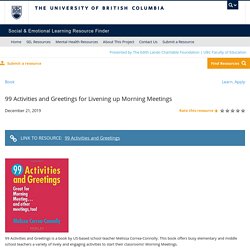
5 Positive Affirmations for Kids that Support a Healthy Inner Dialogue — Yo Re Mi. Twelve Games to Teach Social-Emotional Learning. Help students develop their social and emotional skills with these games.
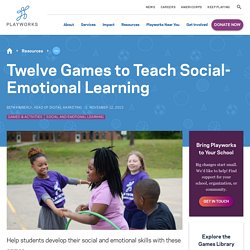
At Playworks, we create a place for every kid on the playground to feel included, be active, and build valuable social and emotional skills. Writing a Personal Mission Statement - SEL Skills. Cameras Off? Here's How to Still Keep Students Engaged. When I log in to my virtual class, I’m multitasking to the 20th degree.

I have 15 tabs open on two different browsers across two monitors. Teachers Share More Life Stories. I’m a writer and an English teacher, so I’ve always used personal stories to connect with people, especially my students.

When we read To Kill a Mockingbird, I talk about my Ewell-like childhood neighbors. During The Outsiders, I tell them about the brothers I went to school with who always reminded me of Soda and Ponyboy. It makes the kids realize that I’m a person, not just a teacher, and it models vulnerability and making connections to the text. These stories usually came up in whole-class discussions … which are pretty impractical over Zoom. Maybe other people are having more luck with it, but we seem to spend half of any discussion saying, “Unmute! But now that I’m only seeing my students on a computer monitor, those personal connections are more important than ever. The problem—well, one of many problems—is that my virtual lessons are incredibly scripted.
SEL Strategies for Helping Kids Manage Emotions in the Classroom. This is going to be a challenging back-to-school season.
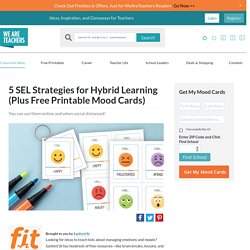
One of the biggest concerns teachers and families are talking about is how to help kids share emotions when we’re online, physically distanced, or while wearing masks. It’s going to feel strange to everyone, but we can’t let that stop us. Understanding, managing, and sharing emotions is a big part of the social and emotional learning work done in grades K through 8. GettingtoKnowYouVirtually. SEL Matters: SEL in A Squiggle.
SEL in A Squiggle Directions: 1) Distribute a "squiggle" to each student. 2) Distribute the same materials to each student (pencil and crayons, markers, etc).
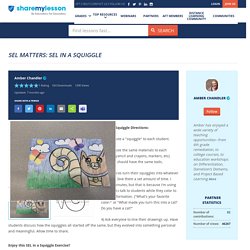
Everyone should have the same tools. 3) Let kiddos turn their squiggles into whatever they like. Give them a set amount of time. 4) Ask everyone to line their drawings up. Check out more free lesson plans and resources in Share My Lesson's Learning at Home: Grades 3-5 Collection or Learning at Home: Grades 6-8 Collection. By Monica Gupta Mehta, M.Ed. (Educational Psychology) How Teachers Can Make Caring More Common. If you’re working with young people, of course you want them to be happy.
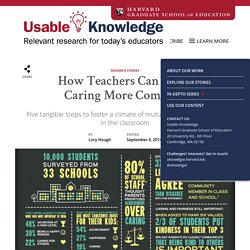
You want them to do well and achieve in life. But what about helping them become more caring for others, and why does this even matter? According to a recent survey of 10,000 middle and high school students published by the Harvard Graduate School of Education’s Making Caring Common Project, caring for others isn’t seen as a top priority. Asked to rank what was most important to them — achieving at a high level, happiness, or caring for others — almost 80 percent of the surveyed students chose high achievement or happiness as their top choice, while only 20 percent chose caring for others. Morningside Center for Teaching Social Responsibility. To the Teacher: As schools and families continue to grapple with the continuing Covid pandemic, one thing we know for sure: This coming school year won’t be business as usual.
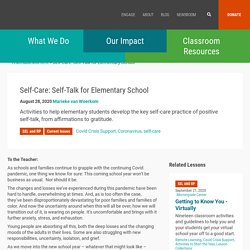
Nor should it be. The changes and losses we’ve experienced during this pandemic have been hard to handle, overwhelming at times. And, as is too often the case, they’ve been disproportionately devastating for poor families and families of color. And now the uncertainty around when this will all be over, how we will transition out of it, is wearing on people. Young people are absorbing all this, both the deep losses and the changing moods of the adults in their lives. As we move into the new school year – whatever that might look like – self-care for us, the adults, is key so we can stay strong and healthy ourselves to support our children at this time.